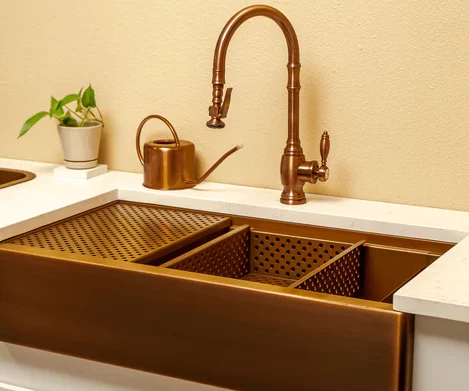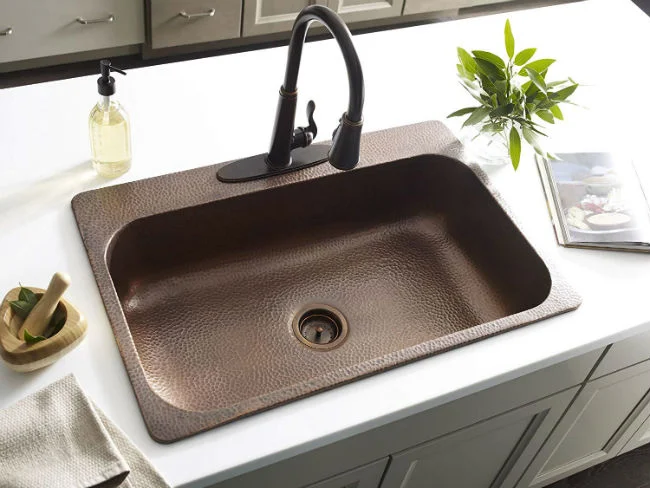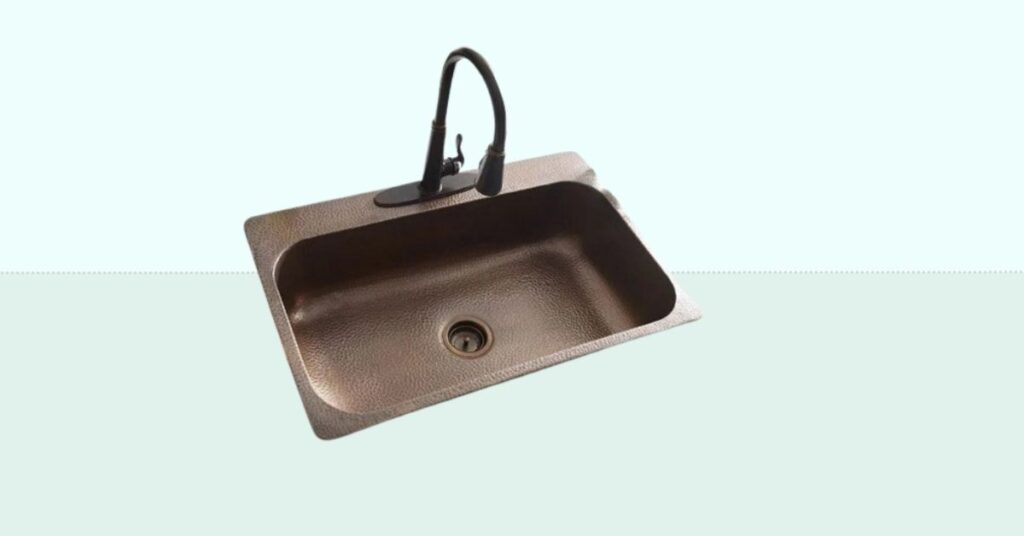Are copper sinks a timeless addition or a fleeting trend in modern kitchens and bathrooms? This query often emerges when homeowners deliberate on their fixture choices. Whether termed as a copper basin, metallic washbasin, or an antique-style sink, copper sinks captivate attention for their allure and distinctiveness.
But What Are the Pros and Cons of Copper Sinks? Read on further to answer the query.
Copper Sinks

Copper sinks, renowned for their distinctive appearance and functional properties, have gained substantial popularity in contemporary kitchen and bathroom design. These sinks, crafted from a metal admired for its unique reddish-brown hue, embody a blend of traditional charm and modern elegance.
Copper sinks offer a captivating blend of aesthetic charm, durability, and functional benefits that make them an appealing choice for discerning homeowners. While their unique properties contribute to an elegant and timeless aesthetic, potential buyers need to consider the associated maintenance requirements and initial investment.
By understanding the pros and cons of copper sinks, homeowners can make informed decisions that align with their specific preferences and lifestyle needs, ensuring the long-term enjoyment of these exquisite and resilient fixtures.
Pros and Cons of Copper Sinks
Here we embark on an exploration of these exquisite fixtures. We delve into the multifaceted aspects that make copper sinks a tantalizing option, while also scrutinizing the potential drawbacks.
I. Pros of Copper Sinks

Copper sinks have become an increasingly popular choice in modern kitchens and bathrooms, adding a touch of rustic elegance to any space. Below are major pros of copper sinks starting with Aesthetic appeal.
A. Aesthetic Appeal
The foremost allure of copper sinks lies in their unparalleled aesthetic appeal. With a warm, rich patina that matures over time, these sinks add a touch of rustic sophistication to any space, creating a visually captivating focal point that effortlessly complements traditional and contemporary decor styles.
B. Durability and Longevity
Copper, known for its exceptional durability and resilience, lends these sinks an impressive longevity. Resistant to corrosion and rust, copper sinks can withstand the rigors of daily use without compromising their structural integrity, making them a long-term investment for any household.
Related: How to Remove Chemical Stains From Stainless Steel Sink – The Fastest Way
C. Antimicrobial Properties
One of the distinctive advantages of copper sinks is their inherent antimicrobial properties. Studies have shown that copper has a natural ability to inhibit the growth of various bacteria, making it an ideal material for maintaining a hygienic environment in kitchens and bathrooms, where cleanliness is paramount.
D. Customization Options
Copper sinks offer an array of customization options, allowing homeowners to tailor their sinks to their specific design preferences. From selecting different textures and finishes to choosing unique shapes and sizes, the versatility of copper enables the creation of bespoke sinks that seamlessly integrate into diverse interior design schemes.
E. Heat Resistance
Copper sinks exhibit remarkable heat resistance, making them an excellent choice for kitchens where hot cookware and boiling water are frequently handled. The heat-resistant nature of copper ensures that the sink remains undamaged even when exposed to high temperatures, providing added peace of mind to homeowners.
II. Cons of Copper Sinks

Like any other material, copper comes with its own set of advantages and disadvantages. Below we discuss some of the cons of copper sinks.
A. Initial Cost
While copper sinks boast numerous benefits, they often come with a relatively higher initial cost than sinks made from other materials. The premium price tag is attributed to the quality of the material, the intricate craftsmanship involved in production, and the unique aesthetic value that copper brings to a space.
B. Maintenance Requirements
Copper sinks necessitate specific maintenance requirements to preserve their lustrous appearance and functionality. Regular cleaning with mild soap and water, avoidance of abrasive cleaning agents, and periodic application of specialized wax or sealants are essential to prevent tarnishing and maintain the sink’s visual appeal over time.
C. Patina Development
Although the patina that develops on copper sinks adds to their charm, some homeowners may view this natural process as a disadvantage, especially if they prefer the initial shine and luster of the copper. The patina, a result of oxidation, may change the sink’s appearance over time, requiring homeowners to embrace the evolving aesthetic or invest effort in removing the patina.
D. Susceptibility to Scratches
Copper sinks, despite their durability, are susceptible to scratches and dents, particularly when exposed to sharp or heavy objects. While these imperfections may contribute to the sink’s rustic character, they can also detract from its visual appeal, necessitating careful handling to maintain its pristine condition.
E. Limited Compatibility with Harsh Chemicals
Copper sinks are sensitive to harsh chemicals and abrasive cleaners, which can accelerate the patina development and cause damage to the sink’s surface. Homeowners must exercise caution when choosing cleaning products, opting for gentle, non-abrasive solutions that effectively cleanse the sink without compromising its integrity.
In Conclusion
In conclusion, copper sinks offer a captivating blend of aesthetic appeal, durability, and antimicrobial properties. However, they do come with considerations such as the initial cost, vulnerability to scratches, and the ongoing maintenance of the patina.
Assessing these pros and cons in line with your preferences and lifestyle will guide you towards making an informed decision, ensuring that your choice of a copper sink aligns seamlessly with your home and personal style.

